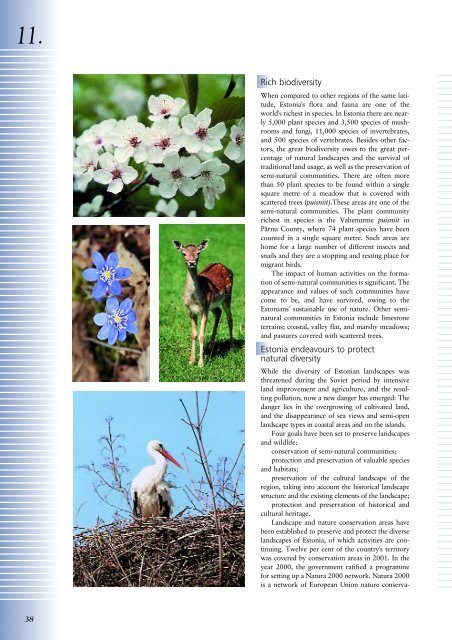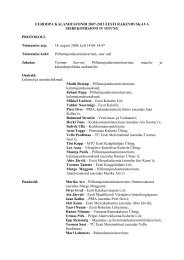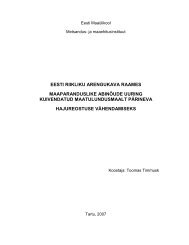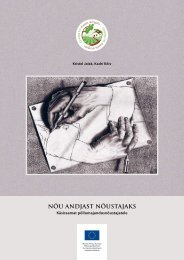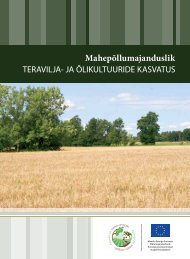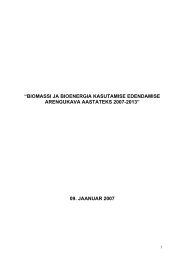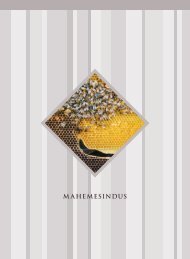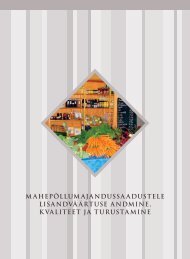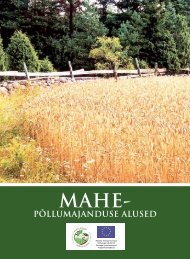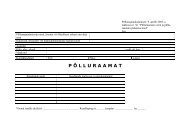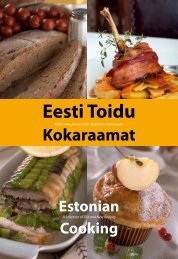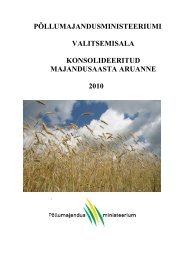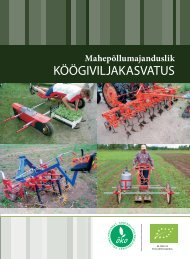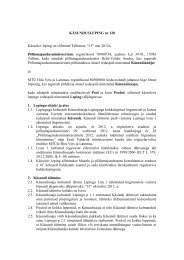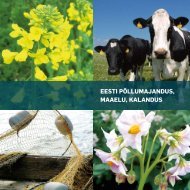estonian agriculture, rural economy and food industry
estonian agriculture, rural economy and food industry
estonian agriculture, rural economy and food industry
Create successful ePaper yourself
Turn your PDF publications into a flip-book with our unique Google optimized e-Paper software.
11.<br />
Rich biodiversity<br />
When compared to other regions of the same latitude,<br />
Estonia's flora <strong>and</strong> fauna are one of the<br />
world's richest in species. In Estonia there are nearly<br />
5,000 plant species <strong>and</strong> 3,500 species of mushrooms<br />
<strong>and</strong> fungi, 11,000 species of invertebrates,<br />
<strong>and</strong> 500 species of vertebrates. Besides other factors,<br />
the great biodiversity owes to the great percentage<br />
of natural l<strong>and</strong>scapes <strong>and</strong> the survival of<br />
traditional l<strong>and</strong> usage, as well as the preservation of<br />
semi-natural communities. There are often more<br />
than 50 plant species to be found within a single<br />
square metre of a meadow that is covered with<br />
scattered trees (puisniit).These areas are one of the<br />
semi-natural communities. The plant community<br />
richest in species is the Vahenurme puisniit in<br />
Pärnu County, where 74 plant species have been<br />
counted in a single square metre. Such areas are<br />
home for a large number of different insects <strong>and</strong><br />
snails <strong>and</strong> they are a stopping <strong>and</strong> resting place for<br />
migrant birds.<br />
The impact of human activities on the formation<br />
of semi-natural communities is significant. The<br />
appearance <strong>and</strong> values of such communities have<br />
come to be, <strong>and</strong> have survived, owing to the<br />
Estonians' sustainable use of nature. Other seminatural<br />
communities in Estonia include limestone<br />
terrains; coastal, valley flat, <strong>and</strong> marshy meadows;<br />
<strong>and</strong> pastures covered with scattered trees.<br />
Estonia endeavours to protect<br />
natural diversity<br />
While the diversity of Estonian l<strong>and</strong>scapes was<br />
threatened during the Soviet period by intensive<br />
l<strong>and</strong> improvement <strong>and</strong> <strong>agriculture</strong>, <strong>and</strong> the resulting<br />
pollution, now a new danger has emerged: The<br />
danger lies in the overgrowing of cultivated l<strong>and</strong>,<br />
<strong>and</strong> the disappearance of sea views <strong>and</strong> semi-open<br />
l<strong>and</strong>scape types in coastal areas <strong>and</strong> on the isl<strong>and</strong>s.<br />
Four goals have been set to preserve l<strong>and</strong>scapes<br />
<strong>and</strong> wildlife:<br />
conservation of semi-natural communities;<br />
protection <strong>and</strong> preservation of valuable species<br />
<strong>and</strong> habitats;<br />
preservation of the cultural l<strong>and</strong>scape of the<br />
region, taking into account the historical l<strong>and</strong>scape<br />
structure <strong>and</strong> the existing elements of the l<strong>and</strong>scape;<br />
protection <strong>and</strong> preservation of historical <strong>and</strong><br />
cultural heritage.<br />
L<strong>and</strong>scape <strong>and</strong> nature conservation areas have<br />
been established to preserve <strong>and</strong> protect the diverse<br />
l<strong>and</strong>scapes of Estonia, of which activities are continuing.<br />
Twelve per cent of the country's territory<br />
was covered by conservation areas in 2001. In the<br />
year 2000, the government ratified a programme<br />
for setting up a Natura 2000 network. Natura 2000<br />
is a network of European Union nature conserva-<br />
38


